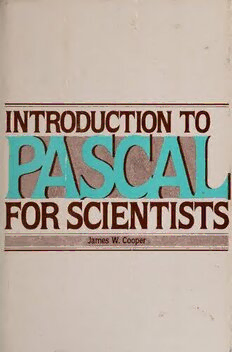Table Of ContentThisguideto programming in Pascal is
the first developed specifically for the
scientist who has little or no program¬
ming experience. Using a step-by-step
format and easy-to-follow examples, it
shows how to write and run efficient
Pascal programs that take full advan¬
tage of the language’s unique facility
for writing clear, structured, error-free
programs.
Readers will find that the book’s exam¬
ples of thoroughly tested complete pro¬
grams offer a much clearer understand¬
ing of programming principles than do
the program fragments usually used in
language manuals. The examples pro¬
gress from elementary programs to
sophisticated ones for matrix diagonal-
ization and inversion, simplex optimiza¬
tion, and the Fourier transform—each
presented here for the first time in the
Pascal language.
All programs are readily usable and
well commented, and good comment¬
ing techniques are stressed repeatedly
as each new programming procedure
is introduced. The book also provides
examples of conversational interactive
programming in Pascal for minicompu¬
ters and time-sharing systems.
The importance of documentation in
developing and refining one’s program¬
ming style is also emphasized. The text
is one of the first to devote an entire
chapter to program documentation and
human engineering of programs.
With its careful adherence to the pro¬
posed standard for Pascal currently
under consideration by the ISO stan¬
dards committee, and its discussions of
common deviations from that standard,
this book forms an authoritative foun¬
dation for the study of the Pascal
language.
Simple and easy to understand, yet
geared for the rigorous computer appli¬
cations of the scientific laboratory,
Introduction to Pascal for Scientists
gives a solid, practical introduction to
one of today’s fastest growing program¬
ming languages.
814
INTRODUCTION TO
PASCAL FOR
SCIENTISTS
Digitized by the Internet Archive
in 2018 with funding from
Kahle/Austin Foundation
https://archive.org/details/introductiontopaOOOOcoop
Introduction to
Pascal for
Scientists
iiiiiiiiiiiiiiiiiiiiiHiiiniiiiimniiniiisiiiiimiiiiiiiMiMiniiMinMmiMiiiMMHiiinniMiniMmiiM
BY JAMES W. COOPER
Vice-President for Software Development
Broker instruments, inc.
Billerica, Mass 01821
A WILEY-INTERSCIENCE PUBLICATION
JOHN WILEY & SONS New York • Chichester • Brisbane • Toronto
Copyright © 1981 by John Wiley & Sons, Inc.
All rights reserved. Published simultaneously in Canada.
Reproduction or translation of any part of this work
beyond that permitted by Sections 107 or 108 of the
1976 United States Copyright Act without the permission
of the copyright owner is unlawful. Requests for
permission or further information should be addressed to
the Permissions Department, John Wiley & Sons, Inc.
Cooper, James William, 1943-
Introduction to PASCAL for scientists.
“A Wiley-Interscience publication.”
Includes bibliographies and index.
1. PASCAL (Computer program language) I. Title.
QA76. 73. P2C68 001.64'24 80-28452
ISBN 0-471-08785-8
Printed in the United States of America
10 987654321
Preface
This text on Pascal was written to provide a simple guide for the scientist
interested in the Pascal language. Early texts were aimed at experienced pro¬
grammers and compiler writers, and the more recent teaching texts have not
been directed at the scientist in particular.
In the present work we present fully working programs in all examples,
rather than program fragments. Each program has been tested and runs as
shown on one or more Pascal compilers. Further, we have commented these
programs much more thoroughly than other authors since we feel that the
comment features of Pascal are one of its strongest points and that no program
can be easily understood without a large number of comments.
In this text we refer to three main compilers: DEC-10 Pascal, UCSD
Pascal, and Aspect Pascal. DEC-10 Pascal was developed at Carnegie-Mellon
University from the Hamburg compiler of Kisicki and Nagel. The UCSD
Pascal compiler was based on the portable p-code compiler developed at the
ETH in Zurich and was further developed under the leadership of Dr. Kenneth
Bowles at the University of California-San Diego. The name “UCSD Pascal”
is a trademark of the Regents of the University of California, and the compiler
is available under license from Softech Microsystems (San Diego, California)
for the PDP-11, Intel 8080, Motorola 6800, 6502, and Texas Instruments 9900.
Aspect Pascal is an interpreter for the Pascal p-code compiler developed
to run under the ADAKOS operating system on the Aspect-2000 minicom¬
puter made by Bruker Instruments. This text is based on a manual that I
originally wrote for Bruker Instruments, Inc., describing Aspect Pascal, and
their permission to use that material is gratefully acknowledged.
In this text I have intentionally used different terminology than Wirth in
a few places to keep the presentation as clear to the novice as possible. In
particular, I have used “calling parameter” for “actual-parameter” and
v
vi Preface
“dummy parameter” for “formal-parameter.” I am also fully aware that my
use of the word “list” is nonrigorous from the computer-science point of view.
I have omitted a few of the newer features of Pascal in the interest of clarity,
such as the variant forms of NEW and DISPOSE and conformant arrays.
The “proposed standard” mentioned throughout the text is the draft pro¬
posal being considered by the ISO standards committee. This proposal is still
under discussion and has not yet been approved, but it comes closest to a
standard that can be cited. Special thanks go to A. Winsor Brown of Point-4
Data Corporation, a member of the ISO standards committee, for his thought¬
ful review of this manuscript.
I would like to thank all of the students in my Tufts Pascal course, as well
as Professor Robert Stolow and Leo Joncas for reading the manuscript and
commenting on it. I would especially like to acknowledge the meticulous
review given the work by Dr. Rolf Johnannesen of the National Bureau of
Standards.
Finally, I would like to acknowledge the cooperation of the Tufts Univer¬
sity Computer Center and the help of George Stalker and Doug Rayner in
obtaining and installing the Carnegie-Mellon University (CMU) Pascal com¬
piler.
James W. Cooper
Billerica, Massachusetts
March 1981

